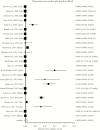Transfusion-Transmitted Malaria: A Systematic Review and Meta-analysis
- PMID: 31334300
- PMCID: PMC6634438
- DOI: 10.1093/ofid/ofz283
Transfusion-Transmitted Malaria: A Systematic Review and Meta-analysis
Erratum in
-
Corrigendum to: Transfusion-Transmitted Malaria: A Systematic Review and Meta-Analysis.Open Forum Infect Dis. 2020 Jan 24;7(1):ofz540. doi: 10.1093/ofid/ofz540. eCollection 2020 Jan. Open Forum Infect Dis. 2020. PMID: 31993455 Free PMC article.
Abstract
Background: Malaria transmission through blood transfusion is an accidental but preventable cause of malaria infection and is increasingly becoming a matter of concern for blood transfusion services. This systematic review was conducted to provide a summary of evidence about the prevalence of Plasmodium infection in asymptomatic blood donors and the effectiveness of screening methods used based on the available literature.
Methods: PRISMA guidelines were followed. Scopus, PubMed, Science Direct, and EMBASE were searched from 1982 to October 10, 2017. All peer-reviewed original research articles describing the prevalence of malaria parasitemia in blood donors with different diagnostic methods were included. The random-effects model was applied to assess the effects of heterogeneity among the selected studies. Incoherence and heterogeneity between studies were quantified by I 2 index and Cochran's Q test. Publication and population bias was assessed with funnel plots and Egger's regression asymmetry test. All statistical analyses were performed using Stata (version 2.7.2).
Results: Seventy-one studies from 21 countries, 5 continents, were included in the present systematic review. The median prevalence of malaria parasitemia among 984 975 asymptomatic healthy blood donors was 10.54%, 5.36%, and 0.38% by microscopy, molecular methods (polymerase chain reaction), and rapid diagnostic tests, respectively. The most commonly detected Plasmodium species was P. falciparum.
Conclusions: This systematic review demonstrates that compared with other transfusion-linked infections, that is, HIV, HCV, and HBV, transfusion-transmitted malaria is one of the most significant transfusion-associated infections especially in Sub-Saharan Africa. Future work must aim to understand the clinical significance of transfusion-transmitted malaria in malaria-endemic settings.
Keywords: Plasmodium; blood donor; systematic review; transfusion medicine; transfusion-associated infections.
Figures





References
-
- WHO, UNICEF. Achieving the Malaria MDG Target: Reversing the Incidence of Malaria 2000–2015. World Health Organization; 2015. https://www.who.int/malaria/publications/atoz/9789241509442/en/
-
- Bruneel F, Thellier M, Eloy O, et al. . Transfusion-transmitted malaria. Intensive Care Med 2004; 30:1851–2. - PubMed
LinkOut - more resources
Full Text Sources

